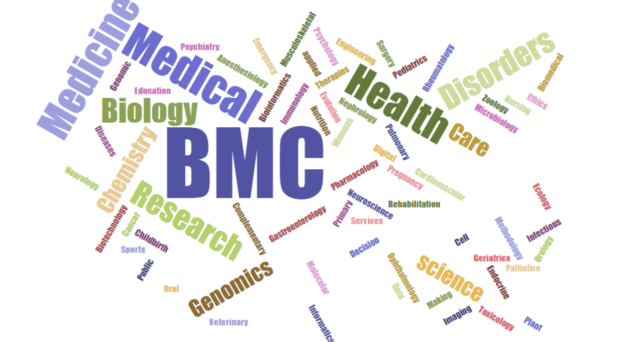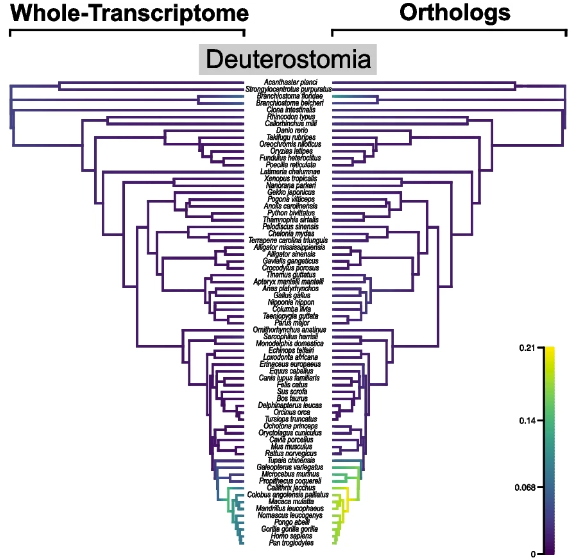
BMC Genomics – Estimating transcriptome complexities across eukaryotes

Alternative splicing is well known to add a tremendous layer of complexity to eukaryotic transcriptomes, increasing exponentially the amount of information that can be stored in a single genomic region; this also offers opportunities for regulatory mechanisms. Traditional comparative transcriptomics is focused on the aim of assigning gene orthology across distantly related organisms, but transcriptome complexity driven by alternative splicing can make this task more and more challenging as genetic distance increases: intron density and distribution can vary by orders of magnitude across taxa. For this reason, focusing on orthologs does not explain the whole evolutionary history, may introduce bias, and can miss important variations throughout evolution.
In this study, complexity metrics independent from orthology, developed with a transcriptome analysis software (TranD), are used to compare the dynamics of conditioning on orthologs versus whole-transcriptome complexity metrics. Instead of separately analysing single genes to estimate their evolutionary distance between species, this method treats whole-genome transcriptome splicing as a global phenotype that can shift across species.
Such an approach is able to mitigate bias issues and to capture genetic novelty more efficiently than ortholog-based approaches. It is also able to reveal higher degrees of complexity in taxa that were thought to be among the least complex. This represents a step forward in the emerging field of non-model evolutionary genomics.
BMC Digital Health – Examining the validity and fidelity of a virtual reality simulator for basic life support training

Training materials simulating clinically relevant scenarios are effective for medical teaching but require much organizational and financial effort. Virtual Reality (VR) technology promises to overcome such barriers and has shown significant educational value in some clinical domains, but its value for training Basic Life Support skills has still to be supported by evidence, especially considering its critical importance.
In this study, the authors evaluated a VR immersive simulator designed for this purpose, considering its validity (is it an accurate representation of the real world training?) and fidelity (does it elicit realistic psycho-behavioral responses from trainees?), taken as major predictors of learning efficiency. Twenty-two medical trainees were asked to perform basic life support tasks on a VR mannequin in a VR environment, then on a real-world mannequin in a real-world setting. The researchers focused on whether behaviors such as self-reported feelings and perceptions or measured eye movement data, as well as performance parameters, were similar between the VR and real-world simulations on a person-by-person basis.
Results showed that the VR simulation passed the validity test: it was sufficiently immersive to make participants feel ‘present’ and they could properly perform procedural assessments. However, movement-based interactions indicated a limited fidelity, as participants displayed higher self-reported workloads, longer times to task completion, and disrupted attentional responses in the VR environment. This suggests that VR may be limited for improving visuomotor skills of Basic Life Support, but is potentially valuable for transferring perceptual and procedural abilities.
BMC Plant Biology – Modifications in steroid and triterpenoid metabolism in Calendula officinalis plants and hairy root culture in response to chitosan treatment

Biostimulants are eco-friendly, non-toxic, biodegradable compounds that promote plant growth and enhance crop productivity, reducing disease risk and plant stress. One of the commonest biopolymers used as biostimulants for organic agriculture is chitosan, a component of fungal cell walls. Chitosan is known to stimulate plant growth, but is also able to elicit plant immunity through the activation of multiple defense-related mechanisms. Plant growth and immunity might become competitive upon chitosan treatment. What happens then to the growth-defense trade-off?
To answer that, researchers exposed Calendula officinalis (marigold) to chitosan and measured an impressive number of parameters including the overall biomass, root and shoot growth, and the levels of several steroids and triterpenoids (responsible for plant growth and immunity, respectively). A general growth inhibition and decreased steroid levels were observed, similarly to what has been demonstrated in other models upon chitosan treatment or fungal infection. Chitosan elicitation had a variable effect on specialized triterpenoid metabolites, which may increase, decrease, or stay unchanged. Overall, the observed effects were different from expected.
These results indicate that chitosan treatment might not always result in enhanced plant growth and fitness: this is a reminder that agricultural solutions, including organic ones, are not universal and require accurate investigation before application. Life is always more complex than its representation and, as such, can always manage to surprise.
BMC Medical Ethics – Clinical ethics consultation documentation in the era of open notes

Clinical ethics consultations have always been widely debated, as there can be competing interests, differing moral values, and disagreement in any given encounter between a patient and an ethics consultant. With the advent of “open notes” in the clinical domain, free, real-time notes are available to patients through online portals, raising concerns about issues such as end-of-life care, autonomy, religious and cultural conflict, and confidentiality.
The authors of this Review consider a narrative-based approach: whose story is being told through open notes? Shared notes can be reviewed and improved by patients, leading ethics committees to better understand their perspectives and map different viewpoints; however this can be time-consuming and not always action-guiding. The authors also focus on content: what should not be shared? There are indeed cases in which sharing would be unnecessary, or even harmful for the patient, so openness would not be recommended, thus undermining transparency and the feeling of trust. For sure, there are already aspects of all clinical encounters that regularly go undocumented… but is it really an issue? Is there a price to pay for openness? Is sharing always appropriate?
Indeed, open notes complicate the documentation of clinical ethics consultations, but this comes with more transparency, relational trust building, and improved patient autonomy. Discussions on clinical ethics consultations are widespread, but interlinking that with the era of open notes is a fresh view on the topic.
BMC Microbiology – Microbial circadian clocks: host-microbe interplay in diel cycles

Circadian rhythms are intrinsic cyclical patterns of gene expression and metabolism that enable organisms to adapt to their changing environment, and are regulated by self-generated molecular clocks. In bacteria, the underlying mechanisms have been well characterized in cyanobacteria, but similar schemes have been recently reported in other microorganisms at the population level, especially in terms of composition and function.
This Review guides readers through some of the most fascinating cases of microbial circadian clocks: from the classic example of cyanobacteria controlled by a three-component negative feedback loop based on cycles of protein sequestration and modification, to the viral-transmitted capacity to produce proteorhodopsin-mediated light-sensitive oscillations in the oceanic bacterioplankton, without forgetting the cyclical effects that, conversely, microorganisms can have on their environment, as in the case of gut microbiota impacting host metabolism in a circadian manner.
A comprehensive understanding of the multiple ways bacteria affect and are affected by environmental time patterns has yet to be achieved. There are many things that we do not know about how endogenous clock systems work across life domains, but it is only a matter of time before new, fascinating mechanisms are discovered.
Comments